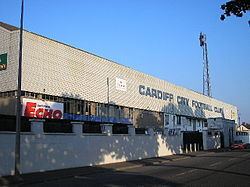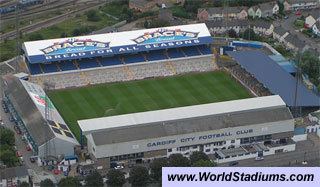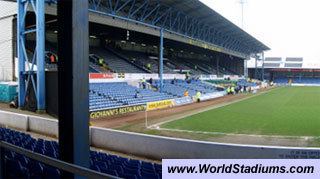Full name Ninian Park Field size 110 x 75 yards Capacity 21,508 Demolished 2009 | Former names Sloper Park Surface Grass Opened 1 September 1910 | |
 | ||
Location Sloper Road, Cardiff CF11 8SX Similar Cardiff City Stadium, Vetch Field, Racecourse Ground, Principality Stadium, Aberdare Hall | ||
Cardiff city goodbye ninian park hello cardiff city stadium
Ninian Park was a football stadium in the Leckwith area of Cardiff, Wales. The site is now a housing development with the same name.
Contents
- Cardiff city goodbye ninian park hello cardiff city stadium
- Cardiff city ninian park minecraft
- History
- Stands
- The Grandstand
- The Popular Bob Bank Seating Terrace
- John Smiths Grange End
- Spar Family Stand
- Transport
- Other usage
- Rugby League Internationals
- Statistics
- Ninian Park housing development
- The new stadium for Cardiff City
- References

Between 1910 and 2009 the Ninian Park stadium was the home ground of Cardiff City F.C, until they moved to the new Cardiff City Stadium (constructed opposite). Ninian Park stadium was subsequently demolished and the site was redeveloped with residential housing.

Cardiff city ninian park minecraft
History

Ninian Park is named after Lieutenant-Colonel Lord Ninian Crichton-Stuart (15 May 1883 – 2 October 1915), son of John Patrick Crichton-Stuart, 3rd Marquess of Bute (12 September 1847–9 October 1900).
The ground featured large floodlights in each corner and a plasma-screen television showed highlights during the game. The television was bought by the club in 2002 from Bolton Wanderers, who had previously used the screen in their former ground Burnden Park before moving to the Reebok Stadium, and was located between the Popular Bank and the Grange End.
The stadium hosted a number of Welsh international fixtures, including the Wales v Scotland World Cup qualifier on 10 September 1985, at which Scotland manager Jock Stein collapsed and died.
The last ever Cardiff City football match played at Ninian Park was a 3-0 defeat to Ipswich Town, who had Roy Keane as their new manager in his first match in charge, on 25 April 2009. The last ever senior player to score at Ninian Park was Jon Stead, then of Ipswich Town and the last player for Cardiff City to score at Ninian Park was Ross McCormack in a 3-1 victory over Burnley in the penultimate senior game at Ninian Park. The club relocated to their new all-seater stadium (capacity - just over 28,000) for the 2009-10 season, and the 99-year-old Ninian Park was demolished later in 2009 to make way for a housing development.
The last ever football match played at Ninian Park was a Welsh Schools Cup Semi-Final fixture between Radnor Road Primary school and Corneli Primary School, with Corneli Primary School edging the game after penalties in front of the Grange End. This left Corneli Primary School's manager, lifelong Cardiff fan Alex Clarke, as the last winning manager at Ninian Park.
Stands
The stadium featured four stands: the Spar Family Stand (formerly known as the Canton End), the John Smith's Grange End (formerly known as the Grange End prior to being sponsored by John Smith's Brewery), the Popular Bank (commonly known as the "Bob Bank") and the Grandstand.
The Grandstand
The Grandstand was a two-tier, all-seater stand, with old-fashioned wooden seats in the upper tier, and modern plastic seating in the lower tier. This stand also had several supporting poles holding up the roof. This stand also housed the area in which the player dressing rooms and tunnel were incorporated, as well as housing the dugouts, the V.I.P. area and the press/media benches.
The Popular "Bob" Bank Seating & Terrace
The Popular Bank had a mixture of covered seating to the rear of the stand, and uncovered standing terrace to the front. The seating had many supportive poles keeping the roof up, and in keeping with the tradition of many football teams, many seats were coloured white and when viewed from above spelled the word Cardiff.
John Smiths Grange End
The John Smiths Grange End became the most vocal area of the ground (from the Bob bank up until the 90's) and was a fully covered terrace, previously uncovered for many years, before its renovation in 2001 after Sam Hammam took over as chairman. It also had several supporting poles, and one section housed the away fans. The away section had terracing to the back and seating at the front. In between the home and away fans was a gap separating opposing fans from home fans. There was also netting in the middle just in case anybody wanted to get to the other side or throw anything. This gap in between the opposing fans came in in 2005 where before there was just a metal fence separating home and away fans.
It was officially opened on 1 September 1928 before a league match against Burnley by the Lord Mayor of Cardiff and could hold 18,000 spectators. The area behind the goal where the stand was built was previously an earth embankment. In the 1946/1947 season a spectator fell through the roof of the Grange End during a game with Bristol City. This hole remained in the Grange End roof until its demolition.The original stand was demolished during the 1977/78 season as structural engineers deemed it to be unsafe and it was replaced by a small, uncovered concrete terrace.
Spar Family Stand
The Spar Family Stand was a fully covered, all-seated stand with several supporting poles along the width of the stand. The club ticket office was also located within this stand where an exterior entrance was provided. The rear of the stand was also home to a number of executive boxes and hospitality areas, although work began in the early 1980s they were not completed until 2001 due to financial difficulties.
Transport
The stadium and surrounding area was served by Ninian Park railway station (on the Cardiff City Line) on one side of Sloper Road and Grangetown railway station (on the Vale Line) on the other side. Trains operate frequently to Central and Queen Street stations.
In addition the stadium was also served by the A4232 dual carriageway, which is approximately 0.7 miles (1.13 kilometres) away from the Leckwith Interchange.
Other usage
Since it was built the ground has been used for numerous other events including:
Rugby League Internationals
List of international rugby league matches played at Ninian Park.
Statistics
Ninian Park housing development
The stadium was handed over to Redrow Homes by Cardiff City chairman Peter Ridsdale on 10 September 2009. Redrow will build 142 new homes on the site, but it will still be known as Ninian Park. A planted square was proposed at the centre of the new housing development, in the area of Ninian Park’s centre spot. It is also possible that street names of Cardiff City legends are being considered, though this is yet to be decided. The first show home of the £24m development was to open by late spring 2010, with a mixture of terraced, detached and semi-detached houses.
The first families moved into the new housing in November 2010. The main road was named Bartley Wilson Way after the founder of Cardiff FC.
The new stadium for Cardiff City
Work started on the new Cardiff City Stadium to replace Ninian Park at the end of 2007 on the site of the Cardiff Athletics Stadium, it was officially opened on 22 July 2009. It holds 33,316 spectators, with foundations in place to increase the capacity to 60,000, if needs be. On 6 August 2008 a contract was signed for naming rights at the stadium after Cardiff City recruited a leading specialist, who provided Arsenal with the Emirates Stadium sponsor to find their stadium a sponsor. Although a fee hasn't been released it is reported to be in excess of £3million over a 100-year period. It is currently called the Cardiff City Stadium, although it is proposed that a sponsor's name will eventually go in front of this.
